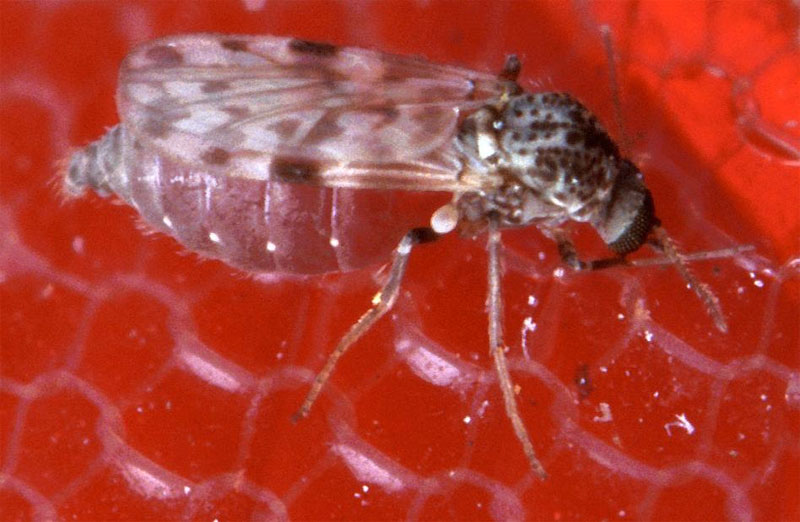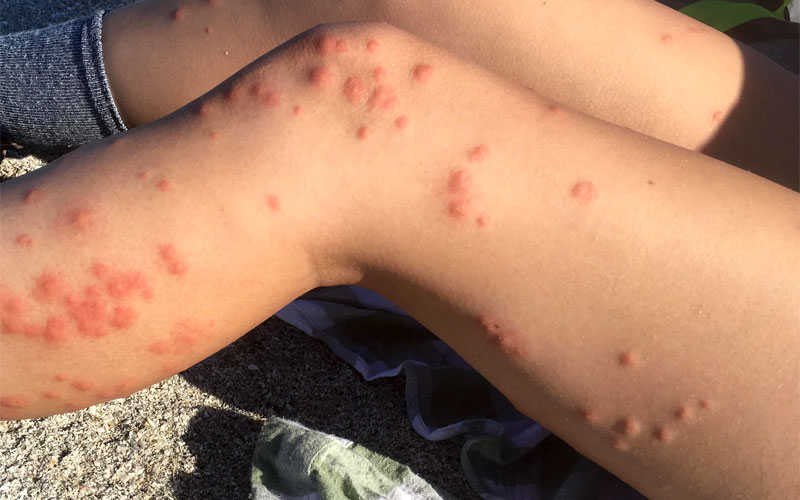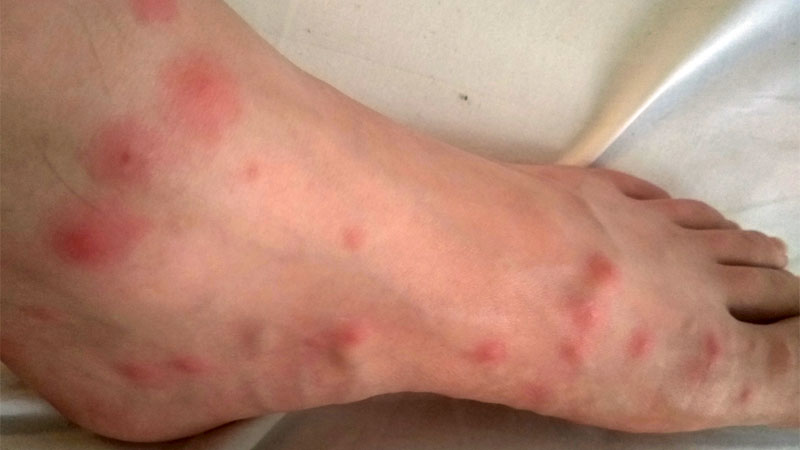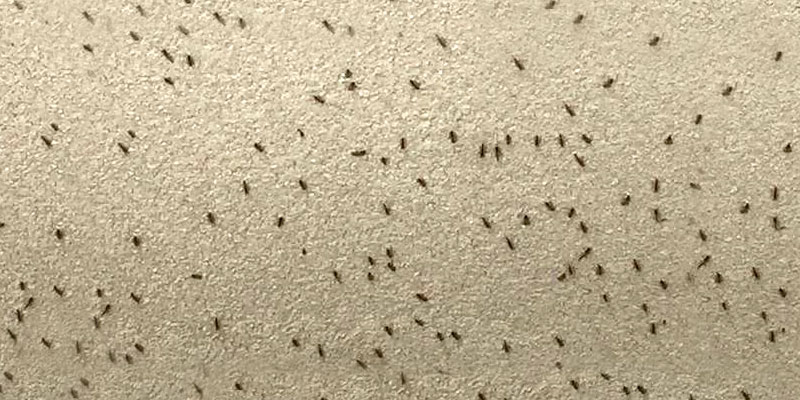“One midge is an entomological curiosity; a thousand can be hell!”
– Doug Kettle
As cute as the name sounds, biting midges (also called “no-see-ums” or sand flies) are anything but.
Adult midges have four small tooth-like mouthparts that slice open your skin to access their blood meals.
Midge bites are treatable, but first we first need to examine what exactly a midge bite looks like and what its symptoms are.
Do Midges Bite?

Not all midges bite, and the term “midge” applies to a wide range of small flies.
The ones we’re discussing belong to the 5,000 species strong family Ceratopogonidae.
They can be found everywhere except the polar regions, and are equally hated everywhere.
But even biting midges don’t all bite.
Only adult female midges actually bite, needing the blood as a protein source for developing her eggs.
What Else Do Midges Eat?
So if only female biting midges bite when they’re getting ready to lay eggs, what do they eat the rest of the time?
Outside of this blood meal, the males and females are actually important pollinators.
In fact, ceratopogonid midges play a significant role in pollinating Theobroma Cacao or the cocoa tree.
Members of the genus Bezzia are believed to feed on mosquito larvae.
Midge larvae require moist environmental conditions to grow, so eggs are often placed at the edge of water or in wet locations such as mangrove swamps.
While we don’t know for certain, it’s believed the larval stage feeds on algae, fungi, bacteria, protozoa, or other organic matter.
In some cases, they’ve also been known to infest rotting fruit.
What Does A Midget Bite Look Like?
Most insect bites cause some redness and a little swelling or pain, but midge attacks are far worse.
The risk of getting bitten is highest in the warmer months when midge numbers rocket.
Adult biting midges will attack in swarms, so you’ll end up with multiple bites in a short time, usually without being able to see what bit you.
At first, reactions to midge bites may resemble mosquito bites, only far more painful and itchy.
They’ll show up as a small bump with a central wound, often within a larger red area.
These bites will often develop into painful little blisters or welts, but that’s sometimes only the beginning.
How Long do Midge Bites Last?
This can vary based on your sensitivity, with the initial red bump and itchiness lasting around 24 to 48 hours.
Blistering may occur during or after this period, if at all.
In many cases, the body’s immune response will result in a widening circle of redness that can be as wide as two inches.
In most cases, all symptoms will fade in about two weeks.
However, it’s possible to develop a severe allergic reaction to midge bites that can last longer.
There’s also a higher risk of spreading diseases to humans than with many other insect bites.
Read Also: What Does a Cockroach Bite Look Like?

Midge Bite Disease Risks
As we’ve already discussed, midge bites can be similar in appearance to mosquito bites but more numerous.
But while the itchiness and pain goes away, there’s a good chance you may end up with something a little more permanent.
While rare, an anaphylactic reaction to midge bites isn’t unheard of.
Symptoms include difficulty breathing and swelling of the throat or tongue.
Even worse, midges are known to transmit a number of pathogens, most of which affect livestock or pets.
Some of these include:
- Arbovirus (including west Nile virus and yellow fever)
- African horse sickness
- Bluetongue disease
- Epizootic hemorrhagic disease
- Parasitic nematodes (which can also infest humans)
Read Also: 14 Bugs That Are Confused With Mosquitoes
How To Treat Midge Bites
Treating midge bits is thankfully easy to do and early treatment can greatly reduce symptoms.
The first thing you’ll want to do is thoroughly wash the wound area.
If you have trouble resisting the urge to scratch, apply some calamine lotion.
Alternatively, you can do what Morgan does and give the bite a quick, sharp slap.
This shocks the nerves for a few seconds, overriding the itch signal.
Personally, I prefer the lotion approach so I look less crazy in class or public.
Antihistamines and tea tree oil are both good ways to reduce symptoms.
An ice pack or bag of frozen vegetables placed on the bite(s) is another good way to dull the itchiness and get some relief.
Finally, some people like to use hot water to reduce itching.
Use the tap or microwave to get some warm water. Don’t make it too hot, though.
Dip a cotton swab in the water and hold it on the bite.
It may initially sting for a couple seconds but the result will be less itching.
If you think you may be having an allergic reaction, call your doctor immediately.
How to Prevent Midges From Biting You
It’s not easy to control biting midges, especially since fogging via insecticides doesn’t work very well outdoors.
Another way of keeping midges at bay is by using residual sprays which can last up to 6 weeks.
Off! and similar bug sprays containing DEET or Picaridin can greatly reduce the risk of bug bites if you apply them before going out.
Citronella does a pretty good job of keeping these critters (and many others) away, so consider using citronella candles around your deck or patio.
Protective clothing can also help, but midges are small enough that they can bite through some thinner fabrics.
You can also try and stay away from swampy wetlands or bodies of water.
Finally, try applying baby oil mixed with Dettol before stepping outside.
Some Final Words on Biting Midges
Flies are always annoying, but dealing with outdoor swarmers like biting midges is far worse.
It’s not easy to eliminate these pests, and possibly even harder to avoid them.
The good news is that only adult females will bite and many insect repellent methods (including eating some garlic with your lunch) will work against them.
If you’re sensitive to bug bites, be sure to apply an antihistamine cream or take an oral antihistamine before going out in summer.
In the event you do get bitten, clean and treat the wound quickly to keep discomfort and risk of infection minimal.
More importantly, be sure to seek medical attention immediately if you have trouble breathing or show any other signs of an allergic reaction.
- How to Identify Skunk Poop (With Pictures) - April 1, 2024
- You Really Don’t Need That Opossum Trap - January 4, 2024
- How to Set a Mouse Trap Without Getting Hurt - December 28, 2023




I live in the Missouri Ozarks. I moved here from Omaha Nebraska and NEVER had this kind of issue with midgets as I have in the Ozarks. They are HORRIBLE, HORRIBLE. After years of trying to figure out what the F…. was biting me, this article explained AND SHOWED EXACTLY THE BITES I AM DEALING WITH. I kept freaking out we had bed bugs and oh yeah went thru all the steps to ensure we did not. Especially since we haven’t been ANYWHERE in 5 years nor anyone staying in our house. MIDGES, oh the words to explain my constant bites and itch and scabs because of the itch. Missouri/Misery!!! Now I know where the saying came from.